
* This post is kindly sponsored by the companies listed at the end of this post, but all opinions are my own. *
After years of travelling with my disability in tow, I am sharing a sponsored series of tips & tricks in the hope that it will give others the confidence to embark on an adventure of their own! This is the second post in the series and it is all about passenger assistance within an airport!
If you have mobility difficulties, you may require additional assistance at the airport. Even if you are fairly mobile, travelling often involves lots of walking; so there are various services in place to assist passengers of all abilities! Under European legislation, your airline is responsible for your care when you are onboard the aircraft. Meaning the airport is responsible for providing special assistance before and after your flight. I naturally assumed that passenger assistance was the same for every airline and airport, but I quickly learnt how wrong I was! Whilst the physical help you may receive during your travels is generally very similar, the process of booking, arriving and communicating differs greatly. So my first piece of advice would be to contact the airline you are flying with immediately after booking, so they can advise you on how to ensure everything is in place.
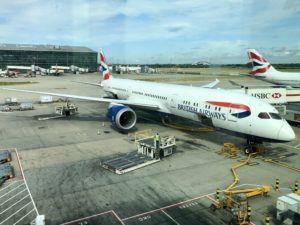
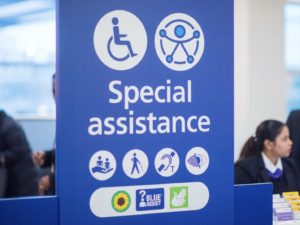
For example; later this week we are flying with British Airways, who allow you to organise your assistance online at the time of booking. All I had to do was tick one of the following options:
Service 1 - Assistance to and from the aircraft, as well as getting around the airport for all or part of your journey either by electric buggy or airport wheelchair.
Service 2 - Assistance to and from the aircraft, as well as getting around the airport for all or part of your journey either by electric buggy, airport wheelchair or your own equipment. Assistance ascending or descending stairs to the aircraft door when the aircraft is parked away from the terminal building. (This means if there isn’t a sky bridge taking you directly from the gate onto the aircraft, they will take you in a little vehicle that will then lift up alongside the aircraft door.)
Service 3 - Full level service listed above. Plus the use of a specialist aisle chair when transferring to your seat during boarding and disembarkation, along with the use of an onboard aisle chair during the flight to move around the cabin when needed.
Another slightly different example is that when flying with Air France, I had to call them up and explain my requirements so they could book the correct assistance on my behalf. As the airline is not responsible for assisting you within the airport, once you have booked your tickets and confirmed your requirements they will pass your information onto the airport and link it to your booking. Although I always contact passenger assistance at the airport to double check everything is in place, because it can be quite stressful when you arrive at the check in desk and find out that your information was never passed on! On the other hand, I have also arrived at the airport to find everything as it should be; but to be safe, I would suggest checking in with both the airline and airport at least 48 hours before your flight! By giving as much notice as possible, it allows passenger assistance enough time to make the appropriate arrangements. But try not to worry if you haven't prebooked, have made a last minute booking or have a unplanned injury, as the team will always do their best to assist you on the day. They just obviously have to prioritise passengers who have booked in advance.
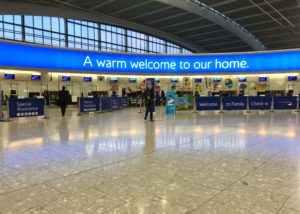
Once you arrive at the airport, you will be given instructions at check in regarding your airport assistance. For some this simply means making your own way through the airport and meeting someone at the gate, who will take care of your equipment and help you board the aircraft. For others, they will need assistance from the moment they arrive! So if you are driving or getting dropped off, there is often a help point to request assistance to the terminal building. Alternatively you will be given a phone number to call upon arrival, to notify the team that you need support from your vehicle or drop off location.
After check in, some airports will ask you to wait in a designated area before or after helping your through security and into departures; allowing the team to help as many passengers as possible. So I would l recommend letting a member of staff know if you would like to do something specific before boarding (such as getting something to eat or visiting a shop), so they can allocate enough time to assist you. I typically always travel with multiple people, so aside from helping me through security we often agree to independently navigate departures and meet back up at the gate. However, I have utilised the waiting areas in the past when travelling with one other person, who was unable to push my wheelchair and carry my medical supplies. It is also a brilliant option for people travelling on their own, as it provides you with the option to have as little or as much help as you need.
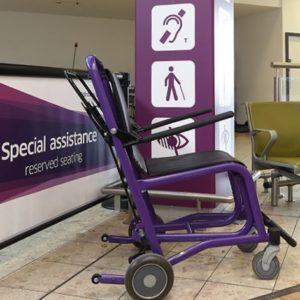
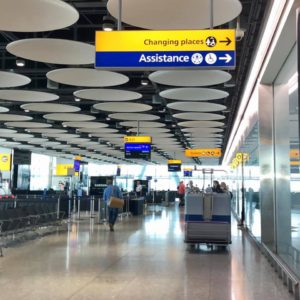
In addition to the passenger assistance waiting areas that are usually located in the middle of a busy/noisy departures lounge, some airports now have alternative facilities available that you can utilise whilst you wait for you flight. For example, Heathrow Terminal 3 has a rest and relaxation room that you can enjoy if you want to escape the sights and sounds of the terminal to a quiet place. Earlier this year Newcastle Airport opened a sensory room, complete a specially-designed bubble tube, calming LED fibre optic ‘softie’, disco ball and padded surfaces, to provide a comfortable and relaxing environment for users. So it is definitely worth looking into what facilities are available at the airport before you fly, because something as simple as a quite space to stretch out can make all the difference to your journey!
After your flight, the airport should be expecting your arrival and will usually meet you at the aircraft door with your wheelchair. Just bare in mind that this can take a while, because they have to unload your equipment from the hold and wait for the other passengers to disembark. For those of you not travelling with your own equipment, they will bring an airport wheelchair/buggy before helping you through passport control, baggage reclaim and into arrivals.
In addition to the varying levels of support passenger assistance has to offer, I have lots of tips and tricks that could make your overall airport experience that little bit easier. So keep an eye out for the next post in this series and let me know if you have any questions!

Hi, I'm Lauren and I have been living with a collection of disabilities for the past 8 years. I initially had a passion for teaching children with special needs, but my health prevented me from pursuring my dream career. Despite this, I now love nothing more than sharing my experiences to help other people living with disabilities.
Hi, I’m Lori and was diagnosed with Ehlers Danlos Syndrome and a family of co-morbid conditions which has made life highly complex. However I constantly aim to make life as ‘normal’ and fulfilling as possible - and through this, I discovered the benefits of writing about my journey.
 GET IN TOUCH
GET IN TOUCH


